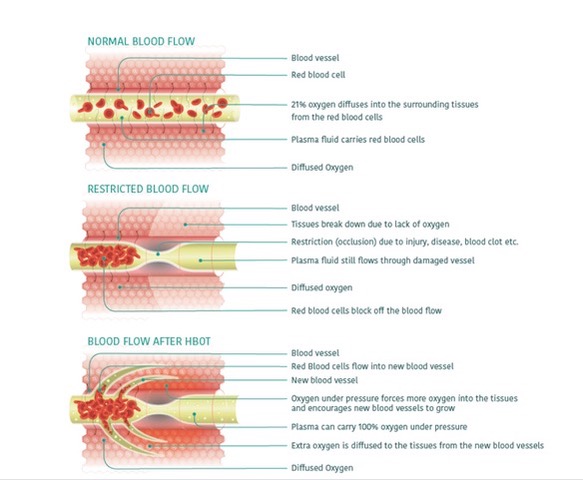MITO HEALTH
What is Hyperbaric Oxygen Therapy?
Hyperbaric oxygen therapy (HBOT) is the use of oxygen in a pressurized environment, at a level higher than 1 atmosphere absolute (ATA). Increased pressure allows for oxygen to dissolve and saturate the blood plasma (independent of hemoglobin /red blood cells), which yields a broad variety of positive physiological, biochemical and cellular effects. The typical treatment lasts for 60-90 minutes, during which the person can relax, take in a mobile phone, read a book, watch a movie or have a sleep.
Hyperbaric Oxygen is widely used throughout the world now and is gaining recognition at an astonishing rate.
HBOT has been demonstrated in many clinical studies and research papers to enhance the body’s innate ability to repair and regenerate. It is used as an adjunct therapy to complement and enhance the healing process in both chronic and acute conditions.
It is similar to a bottle of fizzy drink, the CO2 (carbon dioxide) gas bubbles are under pressure, which decreases the size of the bubbles enough that they dissolve into the liquid. When pressure is released, the volume of each bubble increases and the bubbles appear. While a person is under pressure, the oxygen molecules decrease in size and are able to dissolve into the blood plasma. The oxygen doesn’t rely solely on the red blood cells to be transported while under pressure. The plasma (the white fluid part of the blood) gets to all the tissues, also where blood flow is compromised, as the plasma can go through the blood vessel walls. (unlike the red blood cells) This exponentially increases oxygen delivery throughout the body and makes it possible for oxygen to reach inflamed tissue and support optimal cellular and organ functionality.
The Science Behind Hyperbaric Therapy
The science of a hyperbaric chamber is based on Boyle’s law.
Boyle’s Law, a principle that describes the relationship between the pressure and volume of a gas. According to this law, the pressure exerted by a gas held at a constant temperature varies inversely with the volume of the gas. For example, if the volume is halved, the pressure is doubled; and if the volume is doubled, the pressure is halved. The reason for this effect is that a gas is made up of loosely spaced molecules moving randomly. If a gas is compressed in a container, these molecules are pushed together; thus, the gas occupies less volume. The molecules, having less space in which to move, hit the walls of the container more frequently and thus exert an increased pressure. (www.science. howstuffworks.com)
The physiology which happens in the body while in a hyperbaric chamber is based on Henry’s law.
Concentration of a solute gas (one that is dissolved) in a solution is directly proportional to the partial pressure of that gas above the solution. So, when under an increase of pressure, gases dissolve in liquids to form solutions at an equilibrium between the dissolution and the pressure.

History of Hyperbaric Oxygen Therapy
1772. Carl Wilhelm Scheele, Swedish chemist, discovered oxygen, naming it “fire air”…
1796. Beddoes and Watt published the first book on treatment using oxygen.
1885. E. T. Williams, in the British Medical Journal, made a comment, which would be thought by many to be applicable today.
1895. John Scott Haldane, “father of stage decompression”, demonstrated that mice intoxicated with carbon monoxide would not develop symptoms in hyperbaric oxygen environment at 2.0 bars.
1928. In Cleveland, Dr Cunningham constructed the largest chamber ever built – five stories high and 64 feet in diameter. Each floor had 12 bedrooms with all the amenities of a good hotel. At that time it was the only functioning hyperbaric chamber in the world.
1937. Behnke and Shaw used hyperbaric oxygenation for the first time to treat decompression sickness.
1938. The Brazilians Ozorio de Almeida and Costa used hyperbaric oxygen to treat leprosy.
1942. The Americans End and Long used hyperbaric oxygen to treat experimentally induced carbon monoxide intoxication in laboratory animals.
1954. Churchill-Davidson from Great Britain used hyperbaric oxygen to increase radio-sensitivity of malignant tumors.
1956. Dutch surgeon Ite Boerema, father of modern hyperbaric medicine, commenced with heart surgery in a big hyperbaric chamber, which served as an operation room.
1960. Ite Boerema, experimenting on pigs, demonstrated the possibility of life without blood (erythrocytes) under hyperbaric oxygen conditions.
1961. Boerema and Brummelkamp used hyperbaric oxygen successfully to treat gas gangrene. British Smith demonstrated protective effect of hyperbaric oxygenation in cerebral ischemia.
1962. British Illingworth demonstrated the usefulness of hyperbaric oxygen in the treatment of arterial occlusion of lower limbs.
1963. First international congress on hyperbaric medicine in Amsterdam.
1965. British Perrins reported about positive effects of hyperbaric oxygen in the treatment of osteomyelitis.
1966. American Saltzman showed beneficial effects of hyperbaric oxygen in patients with cerebral insult.
1970. In Czechoslovakia, Boschetty and Cernoch used hyperbaric oxygenation to treat multiple sclerosis.
1971. German Lamm used hyperbaric oxygenation to treat sudden hearing loss. European Underwater and Baromedical Society (EUBS) was founded.
1973. Thurston proved lower mortality rate in the patients with cardiac infarction treated with hyperbaric oxygen.
1970. Expansion of hyperbaric oxygenation begins in Japan and USSR.
1980. Development of hyperbaric oxygenation begins in China.
1983. Dr. Neubauer founded American College of Hyperbaric Medicine.
1986. American Undersea Medical Society becomes Undersea and Hyperbaric Medical Society, practically becoming a world federation.
1987. Swiss Jain introduces HBOT into physical rehabilitation to lower spasticity in patients with hemiplegia after brain insult.
1988. International Society of Hyperbaric Medicine was founded.
